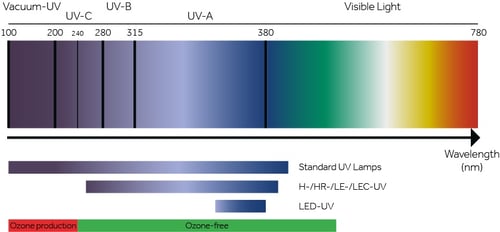 In recent years it has become necessary to double check what exactly is meant when somebody talks about UV-Offset. Nowadays it is not merely UV-Offset printing. There are many more terms and new technologies swirling around, which all have the same idea: Curing UV inks at a lower energy input. We can find H-UV from Komori, while Manroland is marketing LEC-UV. KBA calls it HR-UV and to Heidelberg, it is LE-UV. Additionally UV inks can be cured with even less energy input by using LED-UV, with Ryobi being a pioneer in this technology. What do all these curing processes have in common and what makes them different?
In recent years it has become necessary to double check what exactly is meant when somebody talks about UV-Offset. Nowadays it is not merely UV-Offset printing. There are many more terms and new technologies swirling around, which all have the same idea: Curing UV inks at a lower energy input. We can find H-UV from Komori, while Manroland is marketing LEC-UV. KBA calls it HR-UV and to Heidelberg, it is LE-UV. Additionally UV inks can be cured with even less energy input by using LED-UV, with Ryobi being a pioneer in this technology. What do all these curing processes have in common and what makes them different?
In conventional UV-Offset printing the inks are usually being cured by mercury vapour lamps, which are very energy-intensive and are producing ozone. When it comes to one of the fast curing processes, like H-UV, LE-UV, HR-UV or LEC-UV, the highly reactive inks are cured with a much lower energy input, by using iron-dotted mercury lamps. They work in different wavelengths (see picture below) than the standard UV lamps and the inks are curing only in the spectral UV-A area (close to visible light). As an advantage, the production of ozone is suppressed, as it is produced only in the area between Vacuum-UV to UV-C. Since the special inks are highly reactive and the iron-dotted lamps have higher radiation energy in the UVA and UVB range, the amount of lamps in the printing machine can be reduced and therefore less energy input is needed. Considering additional factors, like less need for cooling and ventilation, the energy saving amounts up to 60-70% compared to standard Offset.

In LED-UV printing the inks only react to the wavelength of the LED lamps in a very limited UV-A range. LED lamps use a fraction of the energy as the standard UV or iron-dotted lamps, therefore the complete energy saving can be as high as 80-90% compared to standard UV printing. As the LED diodes need no warm-up time and there is no heat development, the requirements for cooling have drastically reduced and temperature sensitive substrates can easily be printed. Thus reducing the likelihood of deformation and registration problems since the material is no longer warming up.
Regardless of curing method, whether it be UV, low-energy UV or LED-UV, each of these technologies require their own inks that react to the very specific UV-range in order to cure. It needs to be said that there are substantial energy savings on the one hand, but on the other hand higher investment costs as well as higher costs for the inks. Nevertheless, there is a widespread general interest nowadays for these new drying technologies, as they are very energy efficient, production runs can be sped up due to the faster curing and a very wide range of sensitive substrates can be printed easily.

